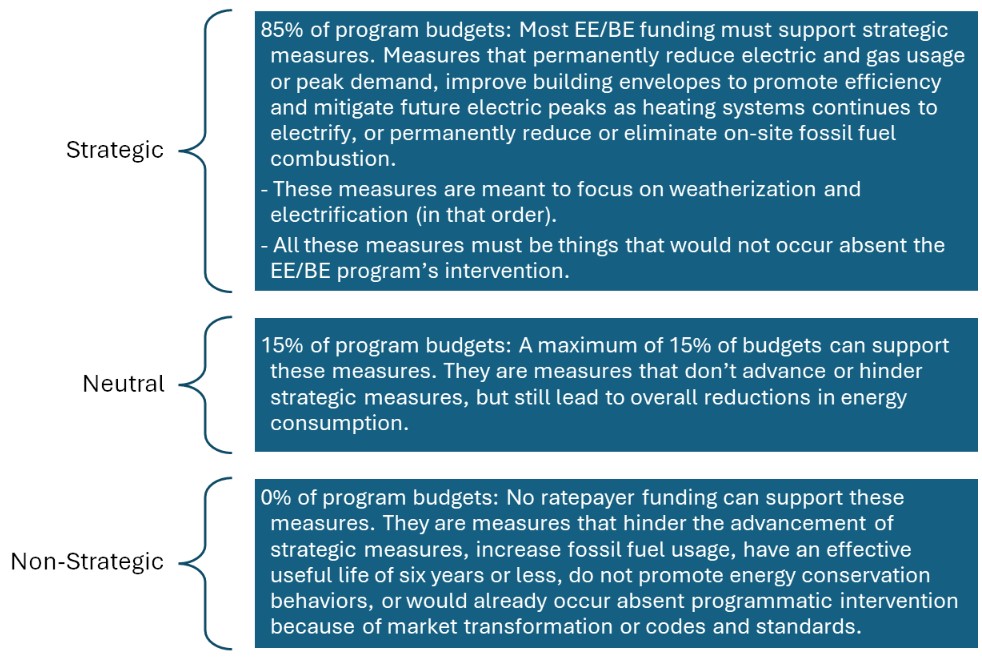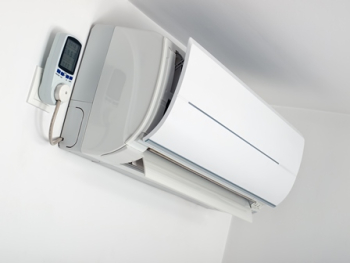

By Luke Miller | Thu, July 31, 25
In May, the New York Public Service Commission (PSC) authorized portfolios for the program administrators’ Energy Efficiency and Building Electrification (EE/BE) Plans for 2026-2030. The PSC issued two orders, one for each of the low- to moderate-income (LMI) and the non-LMI sectors (non-LMI refers to residential, multifamily, and non-residential market segments such as commercial, institutional, and industrial). These authorizations included budgets and targets, cost recovery, elements of program design, and the process to finalize program approval. Over five years, the programs will invest $5.36 billion and the programs will save 615 trillion lifetime BTU (equivalent) over the life of the measures and projects. Nearly 30 percent of the investment, or $1.6 billion, is dedicated to low- to moderate-income households. Additionally, the NY utilities will have a new goal for weatherization savings.
These orders build on past efforts. In 2018, the Department of Public Service (DPS) and the New York State Energy Research and Development Authority (NYSERDA) released “New Efficiency: New York” (NE:NY), which set ambitious economy-wide energy efficiency and greenhouse gas (GHG) emissions reduction goals for 2015 to 2025. Subsequently, the PSC adopted these goals alongside a separate heat pump goal for the state in the 2021-2025 New York Energy Efficiency plans.
While New York has made strides in deploying heat pumps and will continue to invest in heat pump programs in the new orders, the PSC acknowledged that weatherization is a crucial first step to manage both energy affordability and electric load growth in the long-term. In response, these orders make fundamental changes to program regulatory frameworks and priorities. The broad shift away from historically common energy efficiency program measures, like lighting and appliance rebates, and towards weatherization and other more complex energy-saving measures is a major change for the 2026-2030 program cycle.
The shift also raises major new questions and challenges for implementation. How will the state ramp up to achieve the desired scale of deep energy retrofits? Without short-term, behavioral strategies, will administrators be able to achieve deeper, more complex savings and projects? Weatherization projects offer deeper, longer-term energy savings opportunities for customers but they also require deeper trust and levels of commitment from those customers. Similarly, pairing weatherization with heat pump goals has the potential to transform New York’s building stock and its energy use, but will raise new challenges and require new approaches.
This blog post explores three fundamental changes in New York’s portfolios: the shift to a Strategic Framework that creates guardrails around program and measure types, the removal of performance incentives for utilities, and prioritization of building envelope upgrades for both the LMI and non-LMI portfolios.
Shifting Strategies to Achieve Deep Energy Savings
The orders use a Strategic Framework to focus program funds, outline key priorities, and align investments in EE/BE programs with state priorities. This Framework was first introduced in the DPS Staff Energy Efficiency and Building Electrification Report in 2022, and the PSC directed program administrators to follow it in their 2026-2030 proposals in the 2023 Order Directing Energy Efficiency and Building Electrification Proposals. The Framework breaks measures into three categories: strategic, neutral, and non-strategic as shown below.
Source: Chart developed by NEEP using information from the recent NY PSC orders
This approach aims to prioritize measures that will provide long-term savings. Strategic measures heavily focus on those that improve building envelopes to save energy and mitigate future electric peaks. The Framework sets meaningful goals in alignment with state priorities but also takes the unprecedented step of requiring all measures to have effective useful lives (EULs) of more than six years. Under the Strategic Framework, the PSC also explicitly prohibits certain measures that are considered non-strategic (with some situational exceptions): residential gas-fired appliances (including HVAC); commercial gas-fired cooking appliances; lighting measures; electric plug-in appliances; appliance recycling programs; home energy report programs; and online marketplace programs.
Some of these prohibitions, such as eliminating subsidies for new gas-fired appliances when cost-effective electric options are feasible, are consistent with best practices across the region. But other prescriptive requirements, including the removal of all measures with an EUL of six years or less, risk putting up unnecessary barriers for program implementers. This could disallow approaches that can reach many customers, provide an on-ramp to deeper savings, and provide proven ways to target customers to lower energy bills and improve affordability.
Programs that leverage behavioral insights to achieve short-term operational savings can be lower cost and serve as a “foot in the door” to introduce customers to deep energy retrofits. For large energy users, these insights may come in the form of energy management systems. For residences, they may come in the form of home energy reports that provide customers with information on their energy usage and offer ways to reduce usage. These reports are cost-effective ways to maintain consistent engagement with customers to maintain regular communication and help build trust. However, the PSC expressed openness to innovative approaches that encourage true customer behavioral change in service of deep energy retrofits. While initial Implementation Plans are already filed, program administrators should include detailed information in future versions of the Implementation Plans for DPS Staff’s review and approval if they want to propose this kind of program.
As the 2026-2030 portfolios are deployed, the utilities will need to use other methods to generate customer engagement to maximize the reach of the new, more in-depth programs to achieve ambitious goals.
Removal of Performance Incentives for Utilities
Another significant change in the 2026-2030 portfolio is the removal of utility earnings adjustment mechanism (EAM) to incentivize utility program administrator performance like energy usage reduction, peak demand reduction, or energy use intensity reduction. Beginning with the DPS Staff Energy Efficiency and Building Electrification Report in 2022, the DPS began to question the role of EAMs, explaining that they did not fully align with the state’s energy goals that require deeper savings measures that may be more expensive. Building on this, in the 2023 Order Directing Energy Efficiency and Building Electrification Proposals for 2026-2030, the PSC decided to discontinue EAMs in future EE/BE program cycles. Generally, the PSC found that these incentives cost additional money and should not be necessary given existing budgets and targets.
The EAM is a type of Performance Incentive Mechanism (PIM), a financial incentive or penalty that encourages program administrators to achieve higher targets or hit certain performance levels. As ACEEE explained in a 2011 report on redesigning utility business models to better support energy efficiency, PIMs enable utilities to earn a return on energy efficiency investments when they achieve certain goals. This is like how utilities can earn a return from supply-side investments but with added thresholds for when the return kicks in. PIMs have been shown to generate greater investment in energy efficiency, making them an important tool for promoting strong efficiency policy in many states and ensuring that utilities treat and value energy efficiency as a resource.
In contrast to this trend, the NY PSC will no longer offer utility PIMs for the EE/BE programs. The reasons for this determination were to make more efficient use of ratepayer and program funds and ensure programs were designed to achieve long-term goals. Previous cycle PIMs focused heavily on cost savings, which deterred innovation in program design and limited investment in more expensive measures such as building envelope and whole-home electrification measures. This is a large-scale change in how utility energy efficiency programs operate, and it remains to be seen how it will play out. In contrast, similar states like Massachusetts continue to invest in PIMs and modify their structure to encourage market transformation, such as investment in LMI customers, small businesses, and renters. Benefits from savings generated in these communities are tracked on a lifetime basis.
Prioritizing Building Envelope Upgrades in Efficiency and Electrification Programs
In the orders for both portfolios, the PSC directed program administrators to take an “efficiency first” approach to program administration. NYSERDA has defined efficiency first as meeting a minimum level of building envelope performance before receiving incentives for electrification. The PSC believes this will lead to positive outcomes in both the near and long-term: weatherization immediately improves home efficiency and reduces energy usage regardless of fuel type, and it provides future grid benefits, including during winter peaks, as more efficient buildings put less strain on the grid when building owners adopt electric space and water heating technologies. In addition to the Strategic Framework, the PSC ordered the following program changes.
Non-LMI Portfolio Changes
Regional weatherization program: Starting in 2027, program administrators are required to design regional weatherization programs that serve the upstate and downstate regions. The PSC distinguished these two regions because the building stocks of these two regions vary greatly. Most notably, there are far more multifamily buildings downstate, which includes the New York City area. The PSC ordered program administrators to offer the same, streamlined selection of tiers of weatherization projects with different incentive levels to give customers flexibility while aiming to maximize participation.
Dedicated weatherization funding for single family residences: Electric utilities must dedicate at least 25 percent and gas utilities at least 50 percent of total non-LMI budgets to single-family (1-4 units) residential weatherization to achieve the goal of 25.5 million LMMBtu in energy savings. The PSC put this minimum in place because utilities had not proposed to allocate enough funding to weatherization. The PSC emphasized the importance of reducing energy usage and costs for all customers, regardless of how they heat their homes, through weatherization measures.
Heat pump deployment changes: The PSC restricted the existing NY State (NYS) Clean Heat program, a successful heat pump program run by program administrators, to single family (1-4 unit) residential homes. Electric utilities can spend a maximum of 50 percent of non-LMI budgets on electrification measures across all market sectors - including residential, commercial, and industrial - to balance spending between electrification, weatherization, and other program areas. The initial 2026-2030 proposals had allocated 67 percent of the non-LMI EE/BE budgets to electrification measures, with some utilities proposing as high as 78 percent. In the previous cycle, NYS Clean Heat spending far exceeded initial budgets: $454 million was budgeted from 2020-2025, but as of the end of 2024, the program had spent nearly $1.07 billion- approximately 74 percent of the total 2021-2025 EE/BE portfolio budget. The PSC recognizes the efficacy of heat pumps in reducing GHG emissions, but wants to ensure it would not consume too much of the EE/BE program budgets. Additionally, NYS Clean Heat will only fund systems that meet a home’s complete heating load.
Heat pump weatherization requirement: The NYS Clean Heat Program will phase in a weatherization requirement between 2026 and 2028. The program will start by offering higher incentive levels for homes that have been weatherized and will transition, over time, to require full weatherization. Program administrators and the PSC will establish a minimum required level of weatherization during the upcoming planning phase. In addition, the PSC explicitly prohibited the use of EE/BE funds to support partial or hybrid electrification projects, which could otherwise still permit fossil fuel space heating use.
LMI Portfolio Changes
In 2019, the New York legislature passed the Climate Leadership and Community Protection Act (CLCPA), which established a climate justice provision mandating that at least 35 percent, with an aspirational goal of 40 percent, of climate and energy investments benefit disadvantaged communities (DACs). The PSC reinforced this in the Order Authorizing the LMI EE/BE Portfolio for 2026-2030, emphasizing the minimum 35 percent investment goal for geographic disadvantaged communities while continuing to support LMI households that are located outside of these communities. DPS Staff will continue to track utilities’ progress on this goal to ensure investments are reaching these communities.
Shifting Program Administration: All LMI programs across the state will be implemented by NYSERDA, except for multifamily programs which will be done in collaboration with downstate utilities (Con Edison and National Grid). The PSC is aware that electrification can cause bill increases for some LMI households and that providing proper weatherization and health and safety upgrades can mitigate bill increases.
Prioritizing Weatherization First: The LMI plan caps electrification spending at 15 percent of the LMI budget to ensure that program administrators focus on efficiency and weatherization first. The PSC’s LMI electrification principles below explain the PSC’s thought process:
Empower+ Program Updates: Empower+, the existing main program for LMI-sector energy efficiency measures, has been updated to streamline its offerings. The program will cover home energy assessment and installation of some preliminary measures at no cost. After the assessment, additional deeper measures are available at no cost to low-income customers and with a 50 percent subsidy for moderate-income customers.
Removal of Empower+ Incentive Caps: Empower+ incentive caps have been removed for the 2026-2030 cycle. In the previous cycle, these incentives were capped at $10,000 for low-income households and $5,000 for moderate-income households. Now, NYSERDA can offer different incentive levels to ensure customers can participate in the program.
LMI Portfolio Exceptions to Strategic Framework Funding Rules: EE/BE funding can be used for non-strategic measures that can meaningfully advance energy affordability for gas appliances (in LMI multifamily housing), refrigerators, lighting (until 2027), and gas space and water heating systems (in emergency situations). Additionally, program administrators can use up to 10 percent of EE/BE budgets for health and safety measures for LMI customers to allow them to participate in additional efficiency offerings.
Looking Forward
The PSC’s orders have laid new groundwork to prioritize weatherization and continue pursuing electrification strategies in concert with building envelope measures. The PSC hopes this approach will address affordability concerns and help mitigate long-term load growth and winter peaks. While these orders have set the framework, the planning process is still ongoing, Many of the implementation details need to be finalized and challenges need to be addressed. The PSC acknowledges, for example, that weatherization of New York’s existing buildings is a challenging endeavor and will require approaches not yet demonstrated by program administrators in the state.
There are opportunities for further stakeholder input. Below are some key dates for interested stakeholders:
- Case No. 25-M-0248 (Non-LMI Plans): On July 14, program administrators filed their preliminary market-rate EE/BE implementation plans with updated program information.
- By August 13, program administrators will file their joint implementation plans for the regional weatherization programs.
- By September 2, the program administrators will file the NYS Clean Heat Implementation Plan.
- Case No. 25-M-0249 (LMI Plans): By August 22, NYSERDA and the utilities will file a Joint Customer Referral Plan (for customers being referred to NYSERDA’s LMI programs).
- By September 12, program administrators will file their Joint Implementation Plan for the statewide LMI program.
- By September 12, DPS Staff will file a report on the performance management framework for the LMI portfolio.
With multiple transformative changes, new programs, and new implementation processes, New York’s 2026-2030 portfolio will bring interesting changes and challenges to the state’s energy efficiency landscape. We are eager to keep our stakeholders informed of future updates and participate in public comment opportunities on New York’s new programs to help the state achieve goals around energy efficiency, energy affordability, and emissions reductions.




